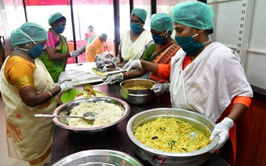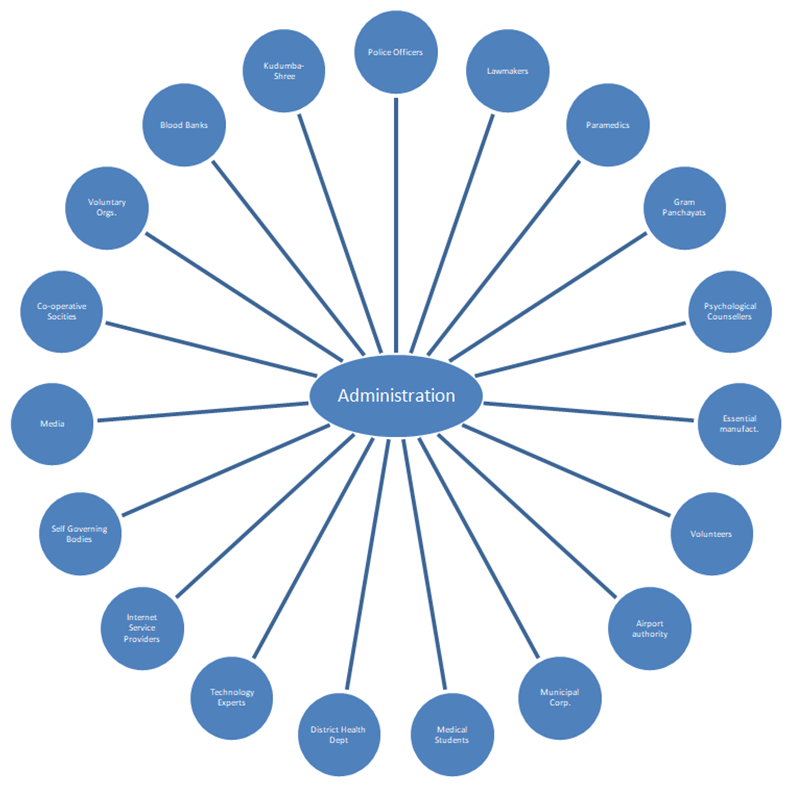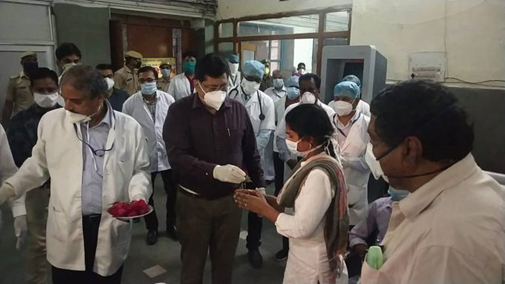The School of Design Thinking presents a series of posts that look at various pandemic stories through the lens of Design Thinking and identify elements that could have led to a better handling of situations. A better handling of situation where every administration across the globe right from the national till district / municipal authority is burning their mid-night oil to fight COVID-19. Apart from introspecting “What could have done better”; we also would like to make a point on “What has been done better” & do we find any relevance of any Design Thinking element which we take inspiration from.
In this article; we would like to relate what two administrations in two different parts of India had done to contain the spread of COVID-19 to “Stakeholder Mapping” – an important Design Thinking tool.
But lets get started with the context from the national point of view. As of 17th April , India had witnessed around 13,000 confirmed cases of COVID-19 . There were around 11,420 active cases and around 1800 patients had recovered. Unfortunately, around 450 had deceased. The nation had undergone Lockdown 1.0 from 25th March till 14th April & had just began the phase of Lockdown 2.0 expected to go till 3rd May. In a broader sense; India did manage to avoid Community Spreading if we were to compare the numbers with nations like USA, Italy, Spain etc. But the battle is far from over till the “Curve is flattened”. Meanwhile two models began to garner praises from different nooks & corners of the globe which form the theme of our today’s article.
In eventuality, these two models solved the “wicked problem”. In Design parlance, these kind of problems are quite complex in nature, involves too much of ambiguity & there is no prior precedence where the problem solvers can take inspiration from. COVID-19 is nothing but a wicked problem. To solve such problems, involving as many and as diverse Stakeholders are needed. Lets take a look at each model & how many diverse stakeholders were incorporated by the administrations.
The Kerala Model
Down South in the Indian peninsula, also dubbed as “God’s Own Country” , Kerala Model of fighting the pandemic began to be recognized not only in India but beyond it. Kerala is known for its higher proportion of literacy , tourism and more importantly for the public healthcare. The state has an experience of successfully combating Nipah & Zika virus apart from the devastating 2019 Kerala floods that tested the grit of the administration. Though the experience of the above catastrophes helped the administration in fighting the COVID-19 pandemic ; however the story is far from over. Lets try to understand which all different stakeholders were involved as we progress.
1) Pathanamthitta Administration’s Efforts of chasing a family: To start with , Kerala witnessed some of the beginning of Indian cases that started in February. Among them was a family who had returned from Italy. Like many other airports across India, the family was quarantined for several days. However, they ran without bothering to alert the hospital. The family of father-mother and a son did developed symptoms yet they were in contact with their relatives and many other acquaintances. However when things went beyond control they admitted themselves.
However, it is worth noticing to see which all different entities were roped in by the collector of the district to track the movement of the family. A task force of Police officers, Paramedics, and volunteers was prepared, and split them into teams. It was very important to identify each and every person whom the family met to avoid the risk of community spreading. A mere addresses of different places was not enough . So the task force also got in touch with the airport authorities, municipal corporations to check the surveillance footage. Additionally, once the family submitted themselves, they validated their search using the family member’s GPS data from their mobile phones.
2) A dedicated Call Center: Pathanamthitta began to emerge as the hotspot of the pandemic as many cases of symptoms surfaced in the media. It was very important to isolate the citizens showing such symptoms. A team of 60 medical students and staff from the district’s health department was commissioned & given an important task to call these citizens requesting them to remain isolated. This was to be done on a daily basis apart from doing the actual job of addressing public queries.
3) Internet Service Providers: As many corporations across the nation began to mull about Working from Home policy for their employees; it was obvious that there would be substantial load on the bandwidth of domestic internet services. The Chief Minister of Kerala appealed to all the service providers to retain the full bandwidth of internet & be in stand-by to resurrect in case of network exigency. This was needed not only to ensure Work From Home runs smooth for the working class but citizens won’t venture out unnecessarily in absence of internet.
4) Delivery of Food to the Mid-Day Meal Beneficiaries After the commencement of Lockdown 1.0 from 24th March; the state administration quickly prepared a team of volunteers and municipal level officials to ensure delivery of food to the children under the state’s Mid-Day Meal . Again the aim was not only to ensure food delivery but thwart any attempt of venturing out of home for search of food.
5) Community Kitchen: Kerala’s community Kitchens proved to be an inspiration for other states especially when it came to taking care of migrants & the homeless along with people under self-isolation who were not in position to take care of food. Across 1255 community kitchens across the state were championed by Self-governing bodies, members of the state-sponsored Kudumbashree project(related to poverty alleviation), Co-operative societies & Voluntary organizations. Around 2.8 lakhs food packets were prepared and distributed per day.
 Image Source: Business Line
Image Source: Business Line
6) Police’s & Lawmakers’ multi-lingual appeal Kerala is a home to many migrants from other states especially from distant West Bengal. It was very important for the migrants to stay back to avoid the risk of community spreading had they travelled. Apart from ensuring they get shelter to stay & food; it was necessary to empathize with them & make them feel safe. Jaidev G, a police officer from Kottayam addressed the migrants in Hindi. He even assured them of preparing food according to their choices but appealed them to stay. Hindi isn’t a predominantly spoken language in South but the police officer walked an extra mile in this case.
Shashi Tharoor , a Member of Parliament from Thiruvananthapuram (Kerala’s capital) made a similar appeal through Twitter in chaste Bangla (mother tongue of the migrants from West Bengal). It is also worth noting that, a well-known lawmaker from West Bengal Mahua Moitra appealed the migrants to stay back in Kerala & expressed faith in Kerala government taking care of them.
The net impact resulted in many of the migrants staying in Kerala.
7) Psychological Counseling : For the people in isolation, it was important to delivery not only essential items through volunteers & Gram Panchayat; but maintain their morale amidst this period. A team of around 30 in the initial stages and later 90 psychological counselors were roped who were in constant touch via IVR (Interactive Voice Response).
8) Essential Manufacturers : Medical officers were at the greatest risk in the fight as they were treating the patients. They wanted masks, PPE kits, the sanitisers, and face shields. In Pathanamthitta district alone 2,000 litres of sanitisers made and supplied over 1,000 face shields. Experts in the area of 3D Technology Printing were hired to prepare 10,000 more masks.
9) Controlling the Fake News Menace : Any crisis is an automatic breeding ground for the anti-social elements. Media played a key role in making quelling rumors & keep citizens on constant vigil for any fake news. Furthermore, Kerala’s district police chiefs are under strict orders to take action on anybody found to be circulating fake news about the viral outbreak on social media.
10) Blood Banks : Even blood banks were alerted to conduct more tests to retain clean samples & stop accepting blood from people who have recently travelled outside the country.
We can continue this article by writing how many more entities also played a key part in fighting the pandemic. But by now you may have got a fair idea of how Stakeholder Mapping is essential in fighting such wicked problems. The result speak for themselves.
 To summarize; these are the stakeholders the administration engaged in the exercise.
To summarize; these are the stakeholders the administration engaged in the exercise.
Case Study:
The Bhilwara Model
Lets travel thousand of miles north to Bhilwara district of Rajasthan. This textile hub of Rajasthan had become one of the hotspots with 27 positive cases & two deaths in matter of couple of days. But what the district administration did in the next couple of days ensured Bhilwara did not register a single case till 18th April & Chief Secretaries of other states are taking inspiration of the same. From the 27 cases tested positive earlier ; 25 have recovered, and 15 have been successfully cured.
Lets take a look at the highlights of Bhilwara model.
1) Survey of Milk Dairies: Rajendra Bhatt , the District collector of the district had a major part of his work-experience in the co-operative sector of Rajasthan. He knew the dynamics of the supply & demand of the essential commodities both in rural and the urban areas. That experience proved of immense importance especially after the announcement of Lockdown1.0 . The district collector sent his team to milk dairies to identify and arrive at a guess of how much milk is consumed per day. This helped in optimum distribution of essential commodities door-to-door.
2) Bringing Industry Leaders & Enteprises Onboard: A total lockdown was a great dampening effect on the textile industry of Bhilwara. The worst to bear the brunt were the daily wage workers. As soon as the announcement of lockdown reached news, the district administration swung into action . The district’s industry in –charge spoke in person to the industry leaders & entrepreneurs requesting them to continue paying a part of wages daily & retain the staff.
3) Special Passes for the payment processors: It was needed for the people involved in administration & payments team of the textile establishments to ensure daily wages’ part was paid to the workers. So, VIP passes were allotted to concerned people for their commutation.
4) Corona Warriors: A team titled ‘Corona Warriors’ was prepared which involved community leaders. Like the case of Kerala ; it was very important to keep anti-social elements at bay & keep the citizens united in spirit to avoid hatred and religious polarization. Appeals by community leaders and religious Gurus of various faiths played a crucial role in maintaining harmony between different sections of society. This team also included Accredited Social Health Activists (ASHA), anganwaadi workers and other local officials such as Sub-Divisional Magistrates’ office & Block Development Officers.
5) Corona Warrior’s Captains: Leaders were appointed from the above warriors teams who in-turn identified folks who will be involved in door-to-door monitoring and spreading awareness As many as 3,000 teams were formed to reach out to entire population of the district and 6,000 people were quarantined.
6) Government Guest Houses & Dharamshalas: The government guest houses proved of immense help as quarantine and isolation facilities. Additionally upon appeals by the administration ; Dharamshalas (dormitory for piligrims & devotees) were also offered by charitable institutions and temple trusts. Since temples and religious activities were totally stopped; these dormitories could be put to a much bigger cause instead of laying empty.
7) Government Hostels & Hostels of Educational Institutions: As maximum students were back to their native with examinations temporarily postponed till further notice; the administration took over the government hostels and sought help from the hostels of various educational institutions which were put for isolation & quarantine services.
8) Importance to Cow-Sheds: On the very day of the announcement of lock-down; strict instructions were given to ensure cow-fodder logistics didn’t see any hiccup in the process considering milk being an essential item.
9) Taking care of the needy: Local officials were also asked to get in touch with social workers, philanthropists and industrialists who wanted to fund food and supply of other essentials to those leading ‘a hand to mouth existence’, truck drivers, street vendors and daily wage workers. This was to ensure the needy one’s don’t venture out unnecessarily in pursuit of food.
As a result of co-operation from as many diverse folks from the district; 92% of population was screened. The numbers look even more staggering considering the district’s population is around 2.4 million (24 lakhs)
 District Collector Mr.Bhatt appreciating the medical fraternity’s effort in containing the pandemic. As a token of appreciation; he gave roses to the medical champions.
District Collector Mr.Bhatt appreciating the medical fraternity’s effort in containing the pandemic. As a token of appreciation; he gave roses to the medical champions.
Source: Money Control.
This turn-around received applause from the entire nation. India’s cabinet secretary Rajiv Gauba in one of the video conferences with state secretaries of various states requested the participants to adopt Bhilwara model in their respective places.
Bhilwara & Kerala models have turned out to be a paradigm for ensuring effective Social Distancing without disrupting the life of population especially the vulnerable sections of society. This was possible since every stakeholder concerned chipped-in with the administration thus adding value in the entire process.
Design Thinking is specially meant to tackle wicked problems where “Stakeholder Mapping” plays a pivotal role . In the course of our workshops, we request the participants to enlist as maximum stakeholders as possible. We teach them various tricks and Design Tools to elicit the list. An effective Stakeholder Mapping thus plays a crucial role in defining a solution that binds all of them together. This leads to development of a holistic solution which caters to everyone. If pandemics such as COVID-19 can be solved with utomost urgeny ; we don’t see Why can’t we solve other complex problems using Design Thinking where we have ample time & resources available to envision a holistic solution.
In a nutshell:
| The Kerala Model |
| The Bhilwara Model |

